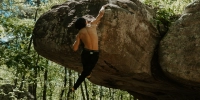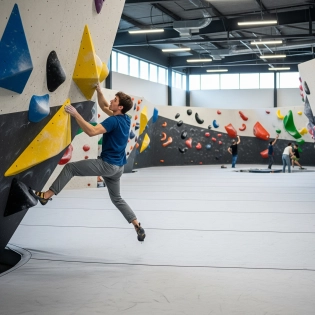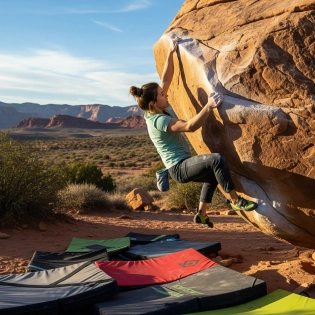








general climbing
After rain, it is generally recommended to wait until sandstone has had enough time to dry thoroughly before climbing on it. The exact duration can vary depending on factors such as the intensity of the rain, temperature, humidity, and the specific characteristics of the sandstone in question. As a general guideline, it is often suggested to wait at least 24 to 48 hours after rain before climbing on sandstone. This allows sufficient time for the rock to dry out, minimizing the risk of damaging the rock or compromising its structural integrity. It's essential to prioritize the preservation and conservation of climbing areas, so it's best to check local guidelines or consult with local climbers who are familiar with the specific sandstone area you plan to climb on.
The forward head posture commonly observed in climbers can be attributed to a combination of factors. Firstly, climbers often need to look up at the wall or route ahead, which naturally leads to a slight forward tilt of the head. Additionally, maintaining a forward-leaning body position helps to shift the center of gravity closer to the wall, enhancing stability and balance during climbing movements. This forward head position, along with the focus on upward visual attention, can result in the appearance of a pushed-forward head posture among climbers.
Rock climbing can be enjoyed by individuals of various body types. While a lean and relatively lightweight body composition can provide advantages in terms of strength-to-weight ratio, there is no specific "best" body type for climbing. Other factors such as technique, flexibility, mental focus, and problem-solving skills also play important roles in climbing success.
Rock climbing requires a certain level of strength, but it's not solely about being strong. Technique, balance, flexibility, and mental focus are also important. Having a baseline level of upper body and core strength is helpful, but climbers of different fitness levels can participate. The required strength varies based on the type of climbing. Bouldering may demand more explosive power, while endurance routes require stamina. Climbing is adaptable to different body types and strengths, and with consistent practice, climbers can develop the necessary strength and skills to tackle more challenging routes.
The time it takes to become proficient or "good" at climbing can vary widely depending on several factors, including your dedication, frequency of practice, natural ability, and the level of difficulty you aim to achieve. While there is no fixed timeline, many climbers start to see noticeable progress within a few months of consistent practice.
With regular training and guidance, beginner climbers can typically develop a solid foundation of climbing skills and techniques within 6 to 12 months. This timeframe allows for building strength, improving technique, and gaining a better understanding of movement and body positioning on the wall.
However, it's important to remember that climbing is a continuous learning process, and skill progression is a lifelong journey. Climbers at different levels continue to refine their techniques and push their limits, striving for higher grades and more challenging climbs.
Ultimately, the speed of progress in climbing is highly individual and dependent on personal factors. The key is to maintain consistency, focus on proper technique, challenge yourself appropriately, and enjoy the process of improvement at your own pace.
Yes, weight can matter in rock climbing. A lower body weight can contribute to a better strength-to-weight ratio, making it easier to pull and hold oneself up on the wall. It can also alleviate strain on the fingers and improve grip strength. Lighter climbers may find it easier to perform dynamic movements and have improved endurance. However, weight is just one factor among many, and success in climbing depends on various factors such as technique, skill, strength, and flexibility.
Climbers often have a lean physique due to the physical demands of the sport and the training involved. Here are a few reasons why climbers tend to be lean:
- Body Weight-to-Strength Ratio: Climbing requires a high strength-to-weight ratio, meaning that having less body weight to carry while maintaining strength is advantageous. A leaner body composition can contribute to improved performance, especially when it comes to pulling and holding oneself up on the rock or wall.
- Endurance Training: Climbing involves prolonged periods of sustained effort and muscular endurance. Endurance training tends to favor a leaner physique as excess body weight can hinder performance over extended periods.
- Upper Body Strength: Climbing places significant demands on the upper body, including the arms, back, and core muscles. Maintaining a lean body composition can enhance relative strength and power in these muscle groups, allowing climbers to move more efficiently on the wall or rock face.
- Weight-to-Surface Area Ratio: Climbers often find themselves needing to push against the rock or wall, utilizing friction and body positioning to maintain balance and stability. A leaner body with less surface area can facilitate better contact and adherence to the climbing surface.
- Energy Efficiency: Carrying excess body weight requires more energy expenditure during climbs. By maintaining a lean body composition, climbers can optimize their energy efficiency and endurance, enabling them to sustain longer and more challenging climbing sessions.
It's important to note that individual body types and genetics can also play a role in a climber's physique. While being lean can be advantageous in climbing, there is no single body type that guarantees success. Climbers come in various shapes and sizes, and the most important factor is developing the strength, technique, and mental fortitude necessary to excel in the sport.
There are several different types of climbing, each with its own characteristics and challenges. They include:
- Bouldering: Climbing shorter routes, typically without ropes, on large boulders or low-lying cliffs. It focuses on powerful moves, technique, and problem-solving skills.
- Sport Climbing: Ascending routes equipped with permanent anchors (bolts) for protection. Climbers use ropes and quickdraws to clip into the bolts as they climb.
- Traditional (Trad) Climbing: Placing and removing removable gear, such as cams and nuts, as you climb. It requires technical skills to protect yourself and the route.
- Top Rope Climbing: Climbing while being securely attached to a rope that runs from the climber, up through an anchor at the top of the route, and back down to a belayer at the bottom.
- Multi-pitch Climbing: Ascending longer routes that are divided into multiple pitches. Each pitch is a section of climbing between two anchor points.
Rock climbing can be physically demanding and challenging on the body. It requires strength, flexibility, endurance, and coordination. The intensity of the climbing experience can vary depending on the difficulty of the routes or problems you attempt. While it is a great way to build strength and improve overall fitness, it can also put strain on your muscles, tendons, and joints. Proper warm-up, stretching, and gradual progression in difficulty are essential to minimize the risk of injuries.





